Looking to add vibrant life to your aquarium? Cryptocoryne plants might just be the perfect choice. Renowned for their impressive variety of species, forms, colors, and sizes, these hardy aquatic plants are popular among both beginners and experienced aquarists alike. Cryptocorynes come in a wide range of sizes, from just a few centimeters to nearly half a meter. Their colors can vary dramatically, spanning hues from yellow to deep brown. The leaves display diverse shapes, including smooth, waved, or spiral forms, making them visually appealing in any tank setup.
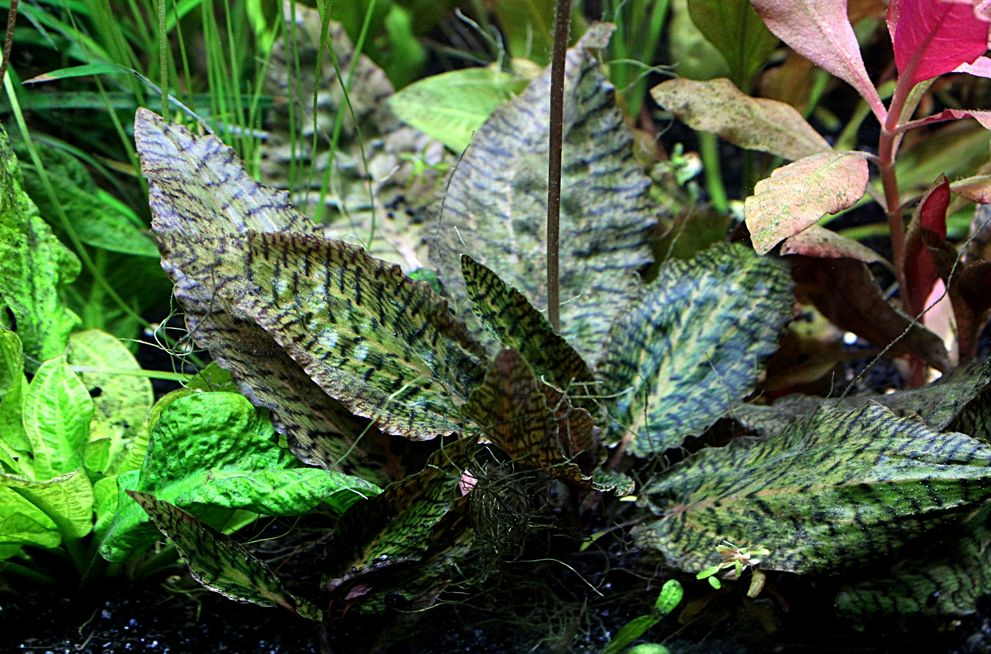
Contents
- 1 Types of cryptocorynes
- 1.1 Cryptocoryne albida ‘Brown’ or Cryptocoryne albida ‘Red’
- 1.2 Cryptocoryne Affinis and Cryptocoryne Affinis Red
- 1.3 Cryptocoryne beckettii ‘petchii’
- 1.4 Cryptocoryne crispatula var. balansae
- 1.5 Cryptocoryne lucens
- 1.6 Cryptocoryne lutea
- 1.7 Cryptocoryne lutea ‘Hobbit’
- 1.8 Cryptocoryne parva
- 1.9 Cryptocoryne Pink Flamingo
- 1.10 Cryptocoryne spiralis
- 1.11 Cryptocoryne undulata
- 1.12 Cryptocoryne Walkeri
- 1.13 Cryptocoryne wendtii Brown and Green
- 1.14 Cryptocoryne x willisii
- 2 Plant Habitat in the wild
- 3 Difficulties in keeping
- 4 Care and keeping in a tank
Types of cryptocorynes
Cryptocoryne albida ‘Brown’ or Cryptocoryne albida ‘Red’
If you’re looking to add a touch of earthy elegance to your aquarium, Cryptocoryne albida ‘Brown’ might be the ideal choice. This captivating plant is known for its distinctive brown or reddish-brown coloration, making it stand out among other varieties of Cryptocoryne albida. Its narrow, elongated leaves can reach a height of around 15-20 centimeters (6-8 inches), providing a lush backdrop in any aquatic setting.
Care Requirements
Cryptocoryne albida ‘Brown’ is relatively undemanding, thriving in moderate to low lighting conditions. It prefers a nutrient-rich substrate to support its growth. While CO2 supplementation is not always necessary, adding it can promote healthier growth and enhance the plant’s rich coloration. Regular water changes and the addition of a balanced liquid fertilizer will also help ensure robust development.
Propagation
Like other Cryptocoryne species, Cryptocoryne albida ‘Brown’ can propagate through the growth of side shoots or produce small flower-like inflorescences that yield tiny seeds. This plant is relatively slow-growing, so be patient as it reaches its full potential in size and appearance.
With its striking coloration and low maintenance requirements, Cryptocoryne albida ‘Brown’ is a fantastic addition for aquarists looking to enhance their aquarium’s beauty and biodiversity.
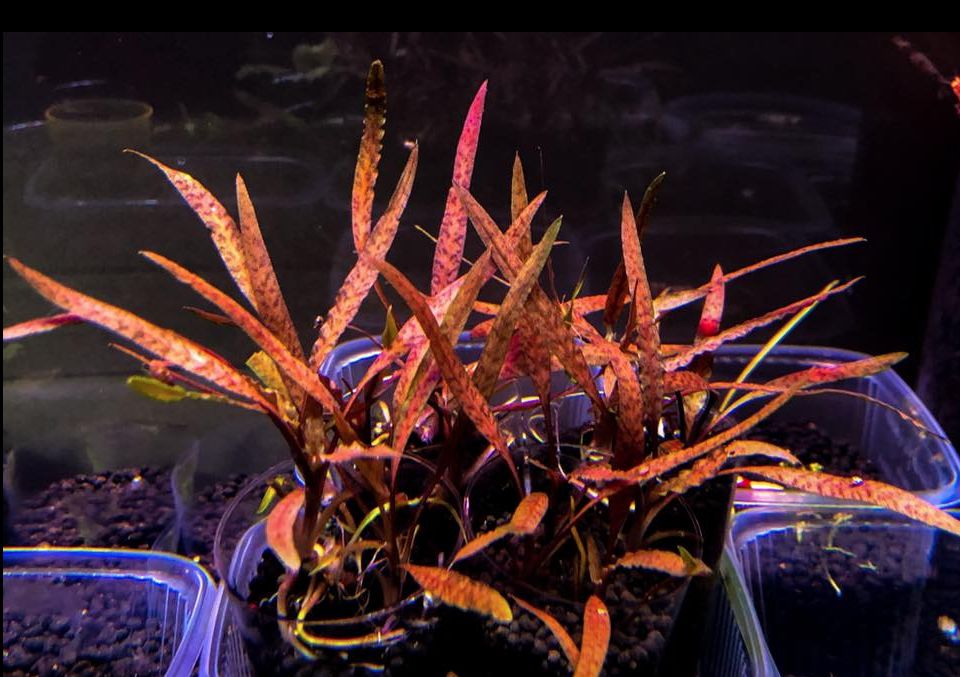
| Characteristic | Description |
|---|---|
| Scientific Name | Cryptocoryne albida ‘Brown’; Cryptocoryne albida ‘Red’ |
| Common Name | Cryptocoryne Albids Red |
| Family | Araceae |
| Color | Brown or reddish-brown |
| Leaf Shape | Narrow and elongated |
| Leaf Size | Approximately 15-20 cm (6-8 inches) in height |
| Lighting | Moderate to low light conditions |
| CO2 Requirement | Not essential but can promote healthier growth and coloration |
| Substrate | Nutrient-rich substrate preferred |
| Planting Technique | Anchor roots in substrate |
| Growth Rate | Relatively slow-growing |
| Propagation | Side shoots and small inflorescences with seeds |
| Care Level | Beginner-friendly |
Cryptocoryne Affinis and Cryptocoryne Affinis Red
Native to Malaysia, this plant is a favorite among aquarium enthusiasts for its attractive appearance and adaptability.
Description
Cryptocoryne affinis features elongated, lanceolate leaves that are relatively narrow compared to other Cryptocoryne species. The leaves often display a gentle wave or undulation, adding to their visual appeal.
Color Variations
The leaf color can vary widely, typically ranging from green to reddish-brown. Notably, some specimens exhibit a striking metallic red hue, leading to its common name, Cryptocoryne affinis ‘metallic red.’ Under optimal conditions, this plant can reach a height of about 15-25 centimeters (6-10 inches).
Growth Rate
As a moderate-growing plant, Cryptocoryne affinis may take some time to establish itself. However, once it adapts to its environment, it can grow steadily and enhance the beauty of your aquarium.
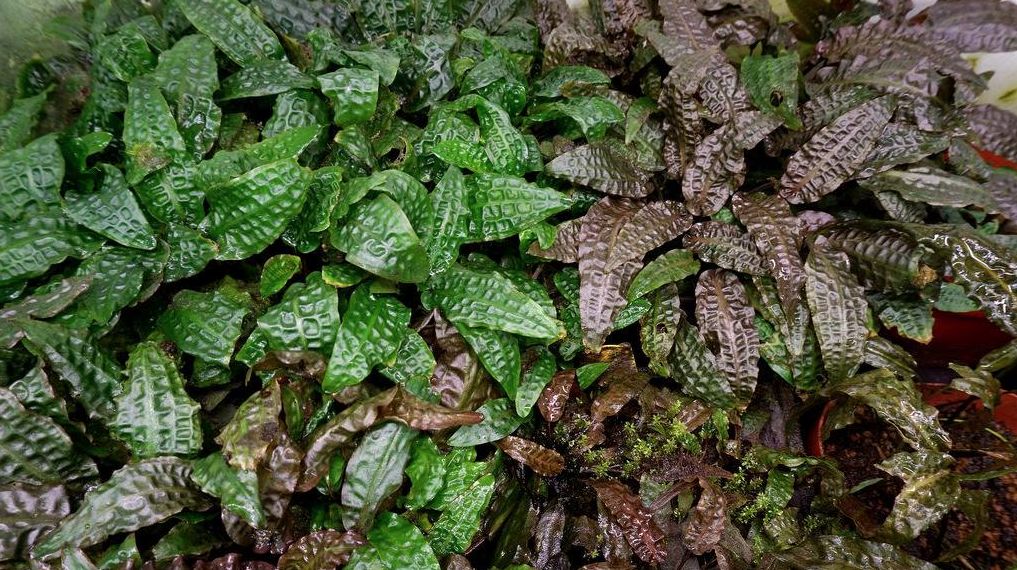
| Characteristic | Description |
|---|---|
| Scientific Name | Cryptocoryne affinis |
| Common Name | Cryptocoryne affinis, Cryptocoryne affinis ‘metallic red’ |
| Family | Araceae |
| Leaf Shape | Elongated, lanceolate |
| Leaf Color | Green to reddish-brown, metallic red in some variants |
| Size | Approximately 15-25 cm (6-10 inches) in height |
| Lighting | Moderate to low light conditions |
| CO2 Requirement | Can benefit from supplemental CO2 but adaptable without it |
| Substrate | Nutrient-rich substrate preferred |
| Growth Rate | Moderate |
| Propagation | Side shoots and inflorescences with seeds |
| Care Level | Beginner to intermediate |
Cryptocoryne beckettii ‘petchii’
Cryptocoryne beckettii ‘Petchii’ is a small variety from Sri Lanka that’s highly sought after for its stunning ornamental qualities. With olive-green leaves featuring reddish-brown undersides, this plant forms lovely small rosettes and typically grows to a height of 10-15 cm.
Placement
Ideal for the front of your planted tank, Cryptocoryne beckettii ‘Petchii’ maintains a uniform growth throughout the year, providing consistent beauty to your aquarium landscape.
Care Requirements
This plant thrives in warmer conditions, with an optimal temperature range of 24-28 °C. While it can survive at 20-22 °C, growth will slow significantly. Aim for a water hardness of 8-16° and maintain a neutral to slightly alkaline pH. Be cautious of abrupt pH shifts or water acidification, as this can cause the plant to shed its leaves. Fortunately, increased alkalinity typically doesn’t harm it.
Lighting
For lighting, moderate to strong, diffused light is best. If direct sunlight is unavoidable, place the plant in the shade to protect it. Cryptocoryne beckettii ‘Petchii’ tends to thrive when positioned in the partial shadow of taller plants, demonstrating a notably high growth rate. A daylight duration of around 8 hours is recommended for optimal health.
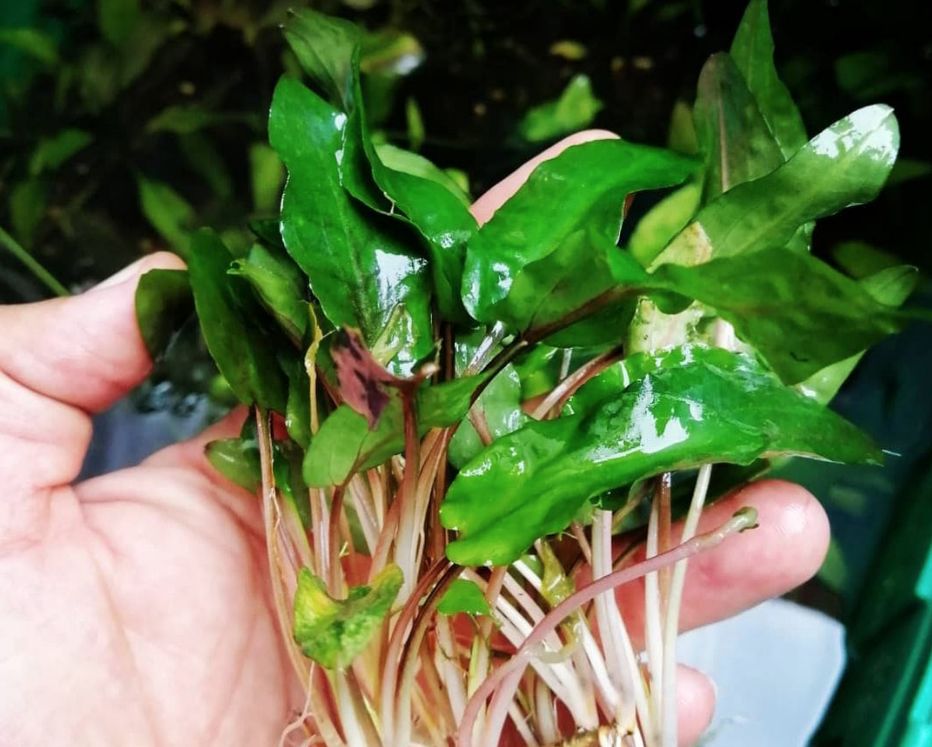
| Characteristic | Description |
|---|---|
| Scientific Name | Cryptocoryne beckettii ‘petchii’ |
| Common Name | Petchii Cryptocoryne, Water Trumpet, Petchii |
| Family | Araceae |
| Leaf Shape | Oblong to lanceolate |
| Leaf Color | Dark green with reddish-brown undertones |
| Size | Can reach a height of 15 cm (6 inches) |
| Lighting | Moderate to low light conditions |
| CO2 Requirement | Can thrive without supplemental CO2, but benefits from it |
| Substrate | Nutrient-rich substrate preferred |
| Growth Rate | Moderate |
| Propagation | Division, adventitious plantlets, and occasional flowers |
| Care Level | Beginner-friendly |
Cryptocoryne crispatula var. balansae
This attractive plant features long, blade-shaped, corrugated leaves and can grow up to 60 cm tall under favorable conditions.
Placement
To maximize its beauty, cultivate this cryptocoryne in a taller aquarium, ideally positioned at the back or along the side walls. Thanks to its ornamental properties and low care demands, it has become a popular choice among aquarists.
Care Requirements
This plant thrives best in tropical tanks, with an optimal water temperature of 24-28 °C. In cooler conditions, growth slows, and it may fail to reach its full height. Temperatures dropping below 18 °C can be detrimental, even leading to the plant’s death.
Ideal Conditions
Cryptocoryne crispatula var. balansae is known for its endurance and ability to adapt to various water hardness levels, although a range of 6-10° is ideal. This species can even be planted in outdoor ponds during the summer months.
While it is relatively low-maintenance, providing optimal conditions will enhance its growth. Ideal parameters include hard, carbonated water, a nutrient-rich substrate containing phosphates, nitrates, and iron, and additional CO2 supply.
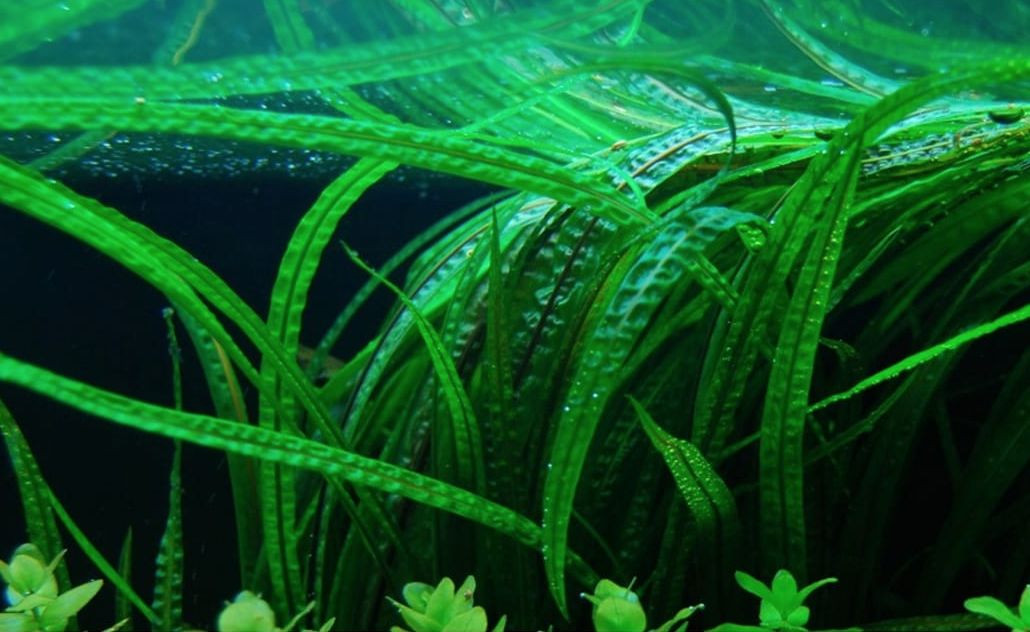
| Characteristic | Description |
|---|---|
| Scientific Name | Cryptocoryne crispatula var. balansae |
| Common Name | Balansae plant, Crypt Balansae |
| Family | Araceae |
| Leaf Shape | Elongated, lanceolate leaves with a distinct tapering tip |
| Leaf Color | Deep green |
| Size | Can reach a height of 30-60 cm (12-24 inches) |
| Lighting | Moderate to high light conditions |
| CO2 Requirement | Can benefit from supplemental CO2 but adaptable without it |
| Substrate | Nutrient-rich substrate preferred |
| Growth Rate | Moderate |
| Care Level | Intermediate to advanced |
Cryptocoryne lucens
If you’re looking for an elegant yet low-maintenance aquatic plant, consider Cryptocoryne lucens. This small, unassuming plant grows to about 10-20 cm tall and forms thick, bright green vegetation. While a single specimen may not stand out, planting a small group at the front of your aquarium creates a visually appealing display.
Care Requirements
Cryptocoryne lucens is comparatively undemanding, making it suitable for both large and small tanks. Like many aquatic plants, it thrives in warm water, with an optimal temperature range of 24-28 °C. While it can tolerate cooler temperatures, its growth rate will significantly slow down.
Ideal Conditions
For the best results, aim for a water hardness higher than 8°, although the plant can adapt to softer water. It prefers a neutral to slightly alkaline pH; acidic conditions can hinder its growth. While regular water changes are beneficial, Cryptocoryne lucens can thrive in older water rich in humic acids.
Planting Tips
When it comes to substrate, choose a well-silted option. New substrates lacking nutrients will slow the plant’s growth. To promote healthy root development, consider placing a small piece of clay mixed with peat under the roots when planting.
Avoid large-grained substrates, as they can impede root growth, causing new plants to cluster too closely to their parents. Instead, opt for fine-grained sand or small pebbles to facilitate root propagation, allowing for a lush, uniformly thick display.
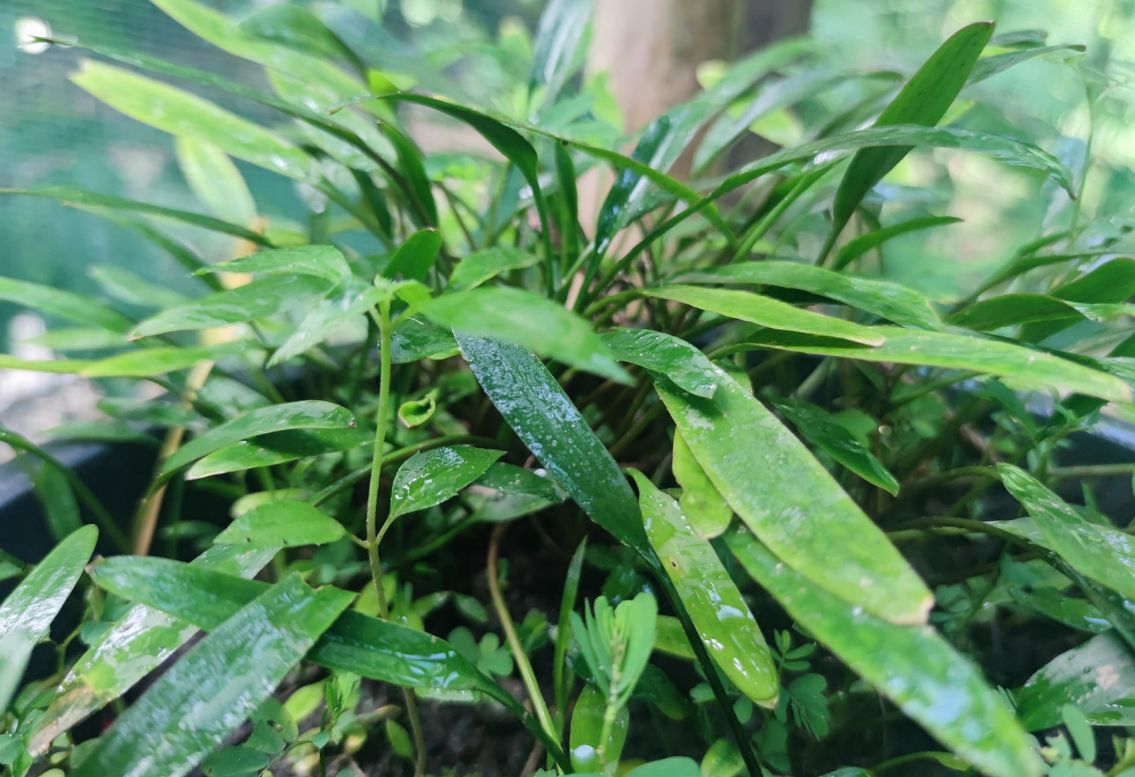
| Characteristic | Description |
|---|---|
| Scientific Name | Cryptocoryne lucens |
| Common Name | Crypt lucens |
| Family | Araceae |
| Leaf Shape | Oblong, lanceolate |
| Leaf Color | Green |
| Size | Can reach a height of 10-20 cm (4-8 inches) |
| Lighting | Moderate to low light conditions |
| CO2 Requirement | Can thrive without supplemental CO2, but benefits from it |
| Substrate | Nutrient-rich substrate preferred |
| Growth Rate | Moderate |
| Propagation | Rhizome division, adventitious plantlets, and occasional flowers |
| Care Level | Beginner-friendly |
Cryptocoryne lutea
One such species is known for thriving in less-than-ideal conditions, making it a great choice for any aquarium setup. With its impressive ornamental characteristics, it can form dense growths reaching heights of 15-20 cm.
Care Requirements
This plant is undemanding when it comes to water composition. It can adapt to a temperature range of 22 to 30 °C, but be aware that growth slows significantly if temperatures drop below 20 °C.
Optimal Conditions
For optimal growth, aim for the following conditions:
- Temperature: 24-28 °C
- Hardness: 4-16°
- pH: 6.8-7.5
Although it prefers slightly alkaline conditions, this species can tolerate acidic water with a pH below 6. It’s also quite resistant to Cryptocoryne Rot. However, be cautious of sudden increases in pH or prolonged exposure to soft, acidic water, as these can lead to leaf shedding.
Maintenance Tips
To prevent stress on the plant, consider performing water changes of 1/4 to 1/3 of the tank volume, using water that matches the original parameters. While regular water changes aren’t strictly necessary, maintaining stability in water conditions is crucial for the health of your Cryptocoryne.
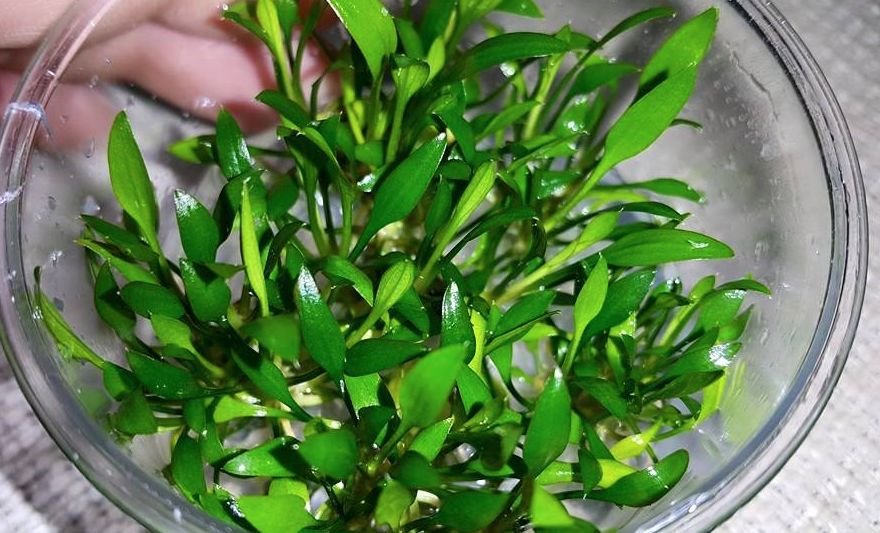
| Characteristic | Description |
|---|---|
| Scientific Name | Cryptocoryne lutea |
| Common Name | Crypt lutea |
| Family | Araceae |
| Leaf Shape | Oblong, lanceolate |
| Leaf Color | Green |
| Size | Can reach a height of 10-20 cm (4-8 inches) |
| Lighting | Moderate to low light conditions |
| CO2 Requirement | Can thrive without supplemental CO2, but benefits from it |
| Substrate | Nutrient-rich substrate preferred |
| Growth Rate | Moderate |
| Propagation | Runners and occasional flowers |
| Care Level | Beginner-friendly |
Cryptocoryne lutea ‘Hobbit’
Cryptocoryne lutea ‘Hobbit’ is a delightful dwarf variant of Cryptocoryne lutea, developed by Dennerle. Perfect for small aquariums, this charming plant reaches a maximum height of just 5 cm, making it an excellent choice for aquarists looking to add lush greenery without overwhelming their space.
Care Requirements
Despite its small stature, Cryptocoryne lutea ‘Hobbit’ is relatively easy to care for. It thrives in various water conditions, making it suitable for both beginners and experienced aquarists.
Optimal Conditions
- Temperature: Ideally, maintain water temperatures between 24-28 °C for optimal growth.
- Hardness: It can adapt to a range of water hardness levels.
- pH: A slightly acidic to neutral pH (around 6.5 to 7.5) is recommended for best results.
Planting and Maintenance
Due to its small size, ‘Hobbit’ can be used effectively in foreground or midground planting. Ensure a nutrient-rich substrate to promote healthy growth, and provide moderate lighting to enhance its coloration.

| Characteristic | Description |
|---|---|
| Scientific Name | Cryptocoryne lutea ‘Hobbit’ |
| Common Name | Crypt lutea |
| Family | Araceae |
| Leaf Shape | Oblong, lanceolate |
| Leaf Color | Green |
| Size | Can reach a height of 5 cm (2 inches) |
| Lighting | Moderate to low light conditions |
| CO2 Requirement | Can thrive without supplemental CO2, but benefits from it |
| Substrate | Nutrient-rich substrate preferred |
| Growth Rate | Moderate |
| Propagation | Runners and occasional flowers |
| Care Level | Beginner-friendly |
Cryptocoryne parva
Cryptocoryne parva is one of the smallest species among the Cryptocoryne family, making it a unique choice for aquarists looking to create a lush, green foreground in their tanks. With leaves measuring only 3-6 cm tall and forming rosettes that are 5-8 cm wide, it produces a charming, bushy appearance with its elongated lanceolate leaves.
Native to the central uplands of Sri Lanka, this species thrives along riverbanks, showcasing its preference for a humid and nutrient-rich environment.
Care Requirements
Due to its specific needs, Cryptocoryne parva is not the most common choice in aquarium husbandry. However, for those willing to meet its requirements, it can be a rewarding addition.
Optimal Conditions
- Light: High illumination is essential for healthy growth. Unlike many other Cryptocoryne species, it thrives best under bright light conditions.
- CO2 Supply: Additional CO2 injection is recommended to enhance growth rates and overall health.
- Substrate: A nutrient-rich substrate is crucial for its development.
Nutrient Sensitivity
This plant is particularly sensitive to deficiencies in iron and potassium. A lack of these nutrients can lead to loss of vibrant green coloring and holes in the leaves, indicating the need for more balanced fertilization.
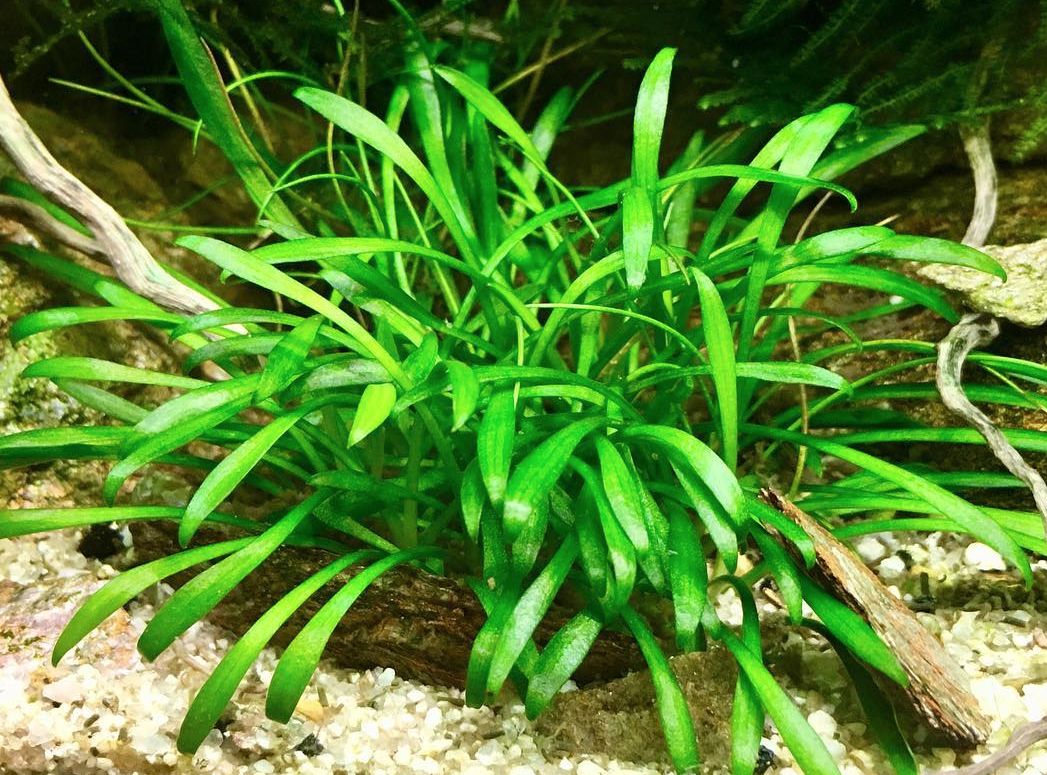
| Characteristic | Description |
|---|---|
| Scientific Name | Cryptocoryne parva |
| Common Name | Crypt parva |
| Family | Araceae |
| Leaf Shape | Lanceolate, narrow |
| Leaf Color | Green |
| Size | Can reach a height of 5-10 cm (2-4 inches) |
| Lighting | Moderate to low light conditions |
| CO2 Requirement | Can thrive without supplemental CO2, but benefits from it |
| Substrate | Nutrient-rich substrate preferred |
| Growth Rate | Slow |
| Propagation | Runner formation, division of daughter plants |
| Care Level | Beginner-friendly |
Cryptocoryne Pink Flamingo
Cryptocoryne Pink Flamingo is an eye-catching variant that has recently gained popularity in the aquarium hobby. Its vibrant pink leaves make it a striking addition to any planted tank, serving as an attractive centerpiece.
Appearance
- Coloration: The most notable feature is its bright pink leaves, which stand out against the typical green hues of other aquatic plants.
- Growth Form: Like other Cryptocoryne species, it forms rosettes, contributing to a lush, bushy appearance.
Care Requirements
While similar to other Cryptocoryne species, there are some specific care guidelines to ensure the health and vibrancy of Cryptocoryne Pink Flamingo:
- Water Parameters: It thrives in stable water conditions. Maintaining consistent temperature, pH, and hardness is crucial.
- Lighting: Moderate to high lighting is recommended to promote healthy growth and enhance its coloration.
- Substrate: A nutrient-rich substrate will support its growth. Incorporating organic matter can help supply essential nutrients.
Availability
As a relatively new variant, Cryptocoryne Pink Flamingo may be harder to find compared to more established species. Its availability can vary, and it might still be considered a rare or limited offering in the aquatic plant market.
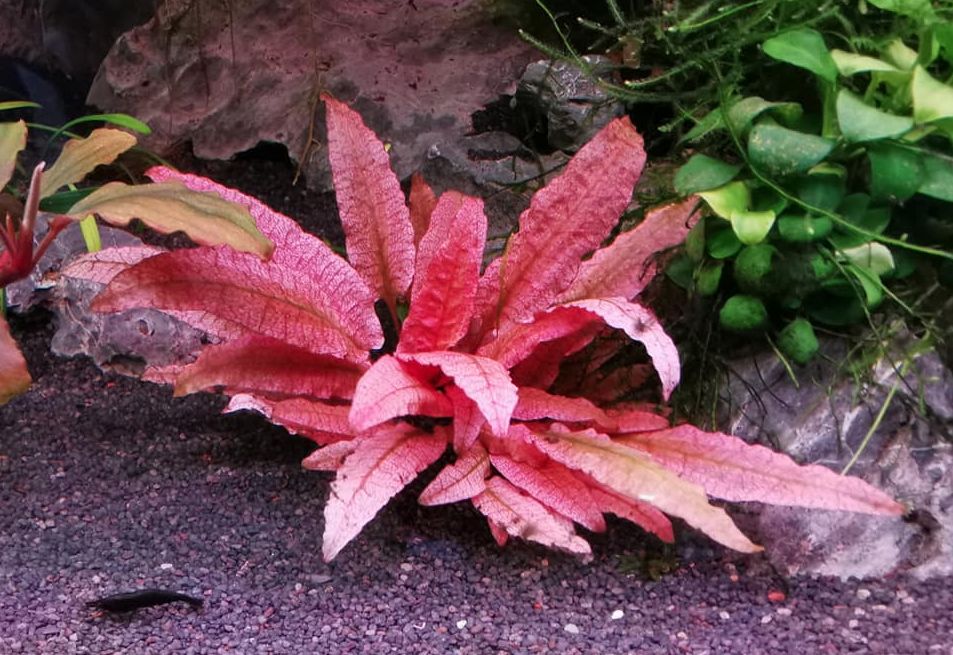
| Characteristic | Description |
|---|---|
| Scientific Name | Cryptocoryne Pink Flamingo |
| Common Name | Pink Flamingo Cryptocoryne |
| Family | Araceae |
| Leaf Shape | Broad, lanceolate |
| Leaf Color | Vibrant pink, ranging from light to dark shades |
| Size | Can reach a height of 10 cm (4 inches) |
| Lighting | Moderate to low light conditions |
| CO2 Requirement | Can thrive without supplemental CO2, but benefits from it |
| Substrate | Nutrient-rich substrate preferred |
| Growth Rate | Moderate |
| Propagation | Cut by rhizome |
| Care Level | Intermediate to advanced |
Cryptocoryne spiralis
Cryptocoryne spiralis is a versatile and attractive aquatic plant known for its distinctive growth forms and adaptability. It thrives in the coastal regions of rivers and streams across India, China, and Thailand, making it well-suited for aquarium cultivation.
Appearance
- Growth Form: The plant develops a bushy rosette of long, ribbon-like leaves that can grow up to 50 cm (20 inches) high in submerged conditions.
- Leaf Characteristics: Leaves are generally bright green to brown, with slightly wavy edges. The length of the leaves can vary significantly depending on whether they are submerged or emersed, reaching about 30 cm (12 inches) underwater and around 15 cm (6 inches) when above water.
- Flowers: The bloom of Cryptocoryne spiralis is unique; it lacks a traditional tube and transforms directly into a convoluted petal with a ragged edge.
Care Requirements
- Water Conditions: Being a floodplain plant, Cryptocoryne spiralis prefers stable water levels and conditions similar to its natural habitat.
- Lighting: Moderate lighting is sufficient for growth, though brighter conditions may enhance its overall appearance and growth rate.
- Substrate: A nutrient-rich substrate can support healthy growth and provide the necessary nutrients for optimal development.
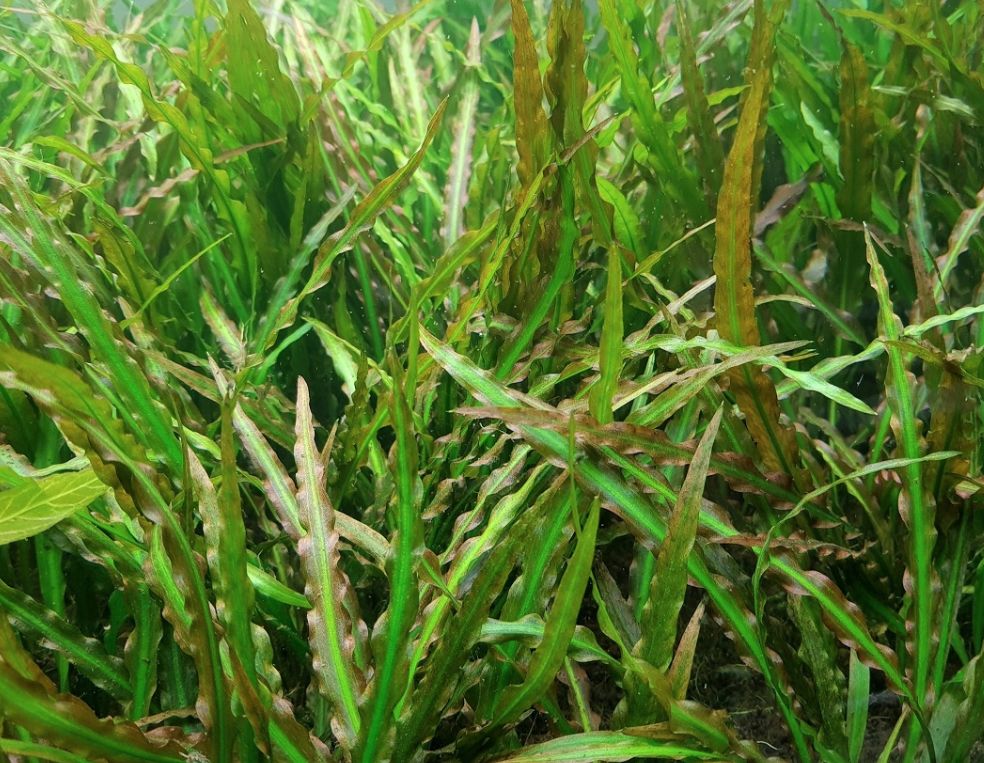
| Characteristic | Description |
|---|---|
| Scientific Name | Cryptocoryne spiralis |
| Common Name | Crypt spiralis |
| Family | Araceae |
| Leaf Shape | Long, narrow, with a hammered texture |
| Leaf Color | Green |
| Size | Can reach a height of 30-50 cm (12-20 inches) |
| Lighting | Moderate to low light conditions |
| CO2 Requirement | Can thrive without supplemental CO2, but benefits from it |
| Substrate | Nutrient-rich substrate preferred |
| Growth Rate | Moderate |
| Propagation | Runners |
| Care Level | Beginner-friendly |
Cryptocoryne undulata
Cryptocoryne undulata is an adaptable and attractive freshwater plant native to central Ceylon (Sri Lanka). Known for its undulating leaves and resilience, it makes an excellent choice for aquariums.
Habitat and Growth Conditions
- Natural Habitat: Cryptocoryne undulata typically thrives in streams and small rivers with varying water hardness, from very soft to hard. The pH usually ranges from 6.8 to 7.4.
- Soil Preferences: This plant can grow in a variety of substrates, from sandy to clayey soils, often found alongside decomposed organic matter.
Appearance
- Leaf Structure: The leaves of Cryptocoryne undulata are wavy and can exhibit a range of green shades, contributing to its ornamental appeal.
- Growth Form: It can form dense colonies, often resembling other species like Cr. beckettii and Cr. wendtii, making identification tricky.
Care Requirements
- Undemanding Nature: Cryptocoryne undulata is known for its ability to adapt to a wide range of environmental conditions, making it suitable for beginners and experienced aquarists alike.
- Reproduction: The plant reproduces readily in aquarium settings, often sprouting new plants from buds on broken stems. It’s beneficial to let these new shoots float until they develop roots before replanting them.
Ideal Uses
- Aquarium Decoration: This plant is perfect for decorating the foreground of planted tanks and can also be used in small home ponds due to its robust nature.
- Compatibility: It often coexists with other Cryptocoryne species, but it’s essential to be mindful of potential hybrids in cultivation.

| Characteristic | Description |
|---|---|
| Scientific Name | Cryptocoryne undulata |
| Common Name | undulata |
| Family | Araceae |
| Leaf Shape | Oblong, lanceolate with wavy edges |
| Leaf Color | Green |
| Size | Can reach a height of 10-20 cm (4-8 inches) |
| Lighting | Moderate to low light conditions |
| CO2 Requirement | Can thrive without supplemental CO2, but benefits from it |
| Substrate | Nutrient-rich substrate preferred |
| Growth Rate | Moderate |
| Propagation | Runner formation, division of daughter plants |
| Care Level | Beginner-friendly |
Cryptocoryne Walkeri
Walker’s Cryptocoryne, is a versatile and attractive aquatic plant native to Sri Lanka. Its popularity among aquarists stems from its ease of care and adaptability.
Appearance
- Leaf Structure: The plant features oblong, lanceolate leaves that create a natural, lush look in the aquarium. The leaves can vary in color, typically ranging from green to reddish tones, depending on lighting and water conditions.
Care Requirements
- Lighting: Cryptocoryne walkeri can thrive in moderate to low lighting, making it suitable for various aquarium setups, including low-tech tanks.
- Substrate: It prefers a nutrient-rich substrate to support healthy growth. Adding a layer of nutrient-rich soil or using root tabs can enhance its development.
- Water Parameters: The plant is adaptable but generally prefers a pH between 6.0 and 7.5 and can tolerate a range of water hardness.
Propagation
- Method: Cryptocoryne walkeri propagates primarily through the formation of runners, which develop new daughter plants. It can also reproduce by dividing existing plants.
- Care for New Plants: Once new plants are established, they can be carefully transplanted to different areas in the aquarium.
Ideal Uses
- Aquarium Decoration: This species is excellent for midground or background planting, contributing to a natural aquascape.
- Compatibility: Cryptocoryne walkeri pairs well with many other aquatic plants and is generally non-aggressive toward tank mates.
| Characteristic | Description |
|---|---|
| Scientific Name | Cryptocoryne walkeri |
| Common Name | Walker’s Cryptocoryne |
| Family | Araceae |
| Leaf Shape | Oblong, lanceolate |
| Leaf Color | Green |
| Size | Can reach a height of 10-25 cm (4-10 inches) |
| Lighting | Moderate to low light conditions |
| CO2 Requirement | Can thrive without supplemental CO2, but benefits from it |
| Substrate | Nutrient-rich substrate preferred |
| Growth Rate | Moderate |
| Propagation | Runner formation, division of daughter plants |
| Care Level | Beginner-friendly |
Cryptocoryne wendtii Brown and Green
Cryptocoryne wendtii is one of the most versatile and popular aquatic plants among aquarists. It is known for its high ornamental value and adaptability, with five main forms distinguished by leaf shape and color:
- Cryptocoryne wendtii ‘Brown’
- Cryptocoryne wendtii ‘Green’
- Cryptocoryne wendtii ‘Compact’
- Cryptocoryne wendtii ‘Broad Leaf’
- Cryptocoryne wendtii ‘Mi Oya’
Appearance
- Variability: The plant’s appearance can change significantly based on tank conditions, making it a fascinating choice for hobbyists.
- Size: Under optimal conditions, Cryptocoryne wendtii typically grows to a height of about 25-30 cm (10-12 inches).
Care Requirements
- Lighting: This plant can thrive in a range of lighting conditions, but moderate to bright light is generally preferred for optimal growth.
- Temperature: It is not particularly demanding regarding temperature, but it thrives best in a tropical tank with an optimal temperature of 24-28 °C (75-82 °F).
- Water Hardness: Medium hardness of 9-16° is ideal. It is less tolerant of very soft water (below 4°), where it may shed leaves due to stress.
- pH Levels: Cryptocoryne wendtii can adapt to both weakly acidic and slightly alkaline conditions, making it versatile in various setups.
Planting and Positioning
- Placement: While it can be grown in smaller tanks, it is best positioned in the midground of larger aquariums. It forms bushy arrangements that can enhance the aesthetic of the tank.
- Growth Rate: It grows uniformly year-round, provided with stable conditions.
Additional Notes
- Resistance: Compared to other Cryptocoryne species, it is less prone to Cryptocoryne Rot, making it a more resilient option.
- Maintenance: Regular water changes and monitoring of water parameters will help maintain plant health.

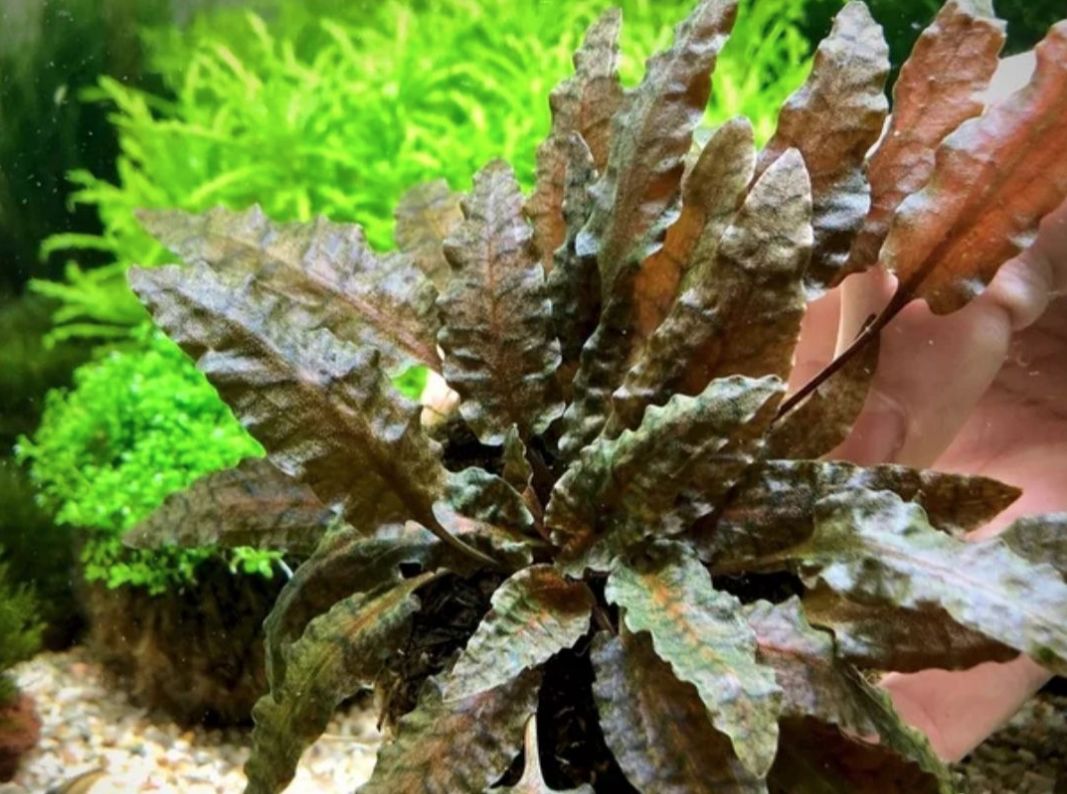
| Characteristic | Description |
|---|---|
| Scientific Name | Cryptocoryne wendtii |
| Common Name | Wendt’s Cryptocoryne |
| Family | Araceae |
| Leaf Shape | Oblong to lanceolate |
| Leaf Color | Varies depending on variety: Green, brown, bronze, or red |
| Size | Can reach a height of 10-20 cm (4-8 inches) |
| Lighting | Moderate to low light conditions |
| CO2 Requirement | Can thrive without supplemental CO2, but benefits from it |
| Substrate | Nutrient-rich substrate preferred |
| Growth Rate | Moderate |
| Propagation | Runner formation, division of daughter plants |
| Care Level | Beginner-friendly |
Cryptocoryne x willisii
Cryptocoryne x willisii is a hybrid aquatic plant resulting from a cross between Cryptocoryne walkeri and Cryptocoryne beckettii. It’s well-regarded in the aquarium hobby for its aesthetic appeal and ease of care.
Appearance
- Leaf Shape: The plant typically features lanceolate-shaped leaves, which can vary in size.
- Coloration: Most commonly, the leaves are green, but some variations may exhibit reddish hues, adding visual interest to aquascapes.
Care Requirements
- Adaptability: Cryptocoryne x willisii is known for its adaptability to various aquarium conditions, making it a suitable choice for both beginners and experienced aquarists.
- Lighting: It thrives in moderate lighting but can also tolerate lower light conditions, although growth may slow down.
- Temperature: Optimal water temperature ranges from 24-28 °C (75-82 °F).
- Water Parameters: It can adapt to a range of water hardness and pH levels, but stable conditions will help it flourish.
Planting and Positioning
- Placement: This hybrid is versatile and can be placed in the midground or background of the aquarium, contributing to lush, green coverage.
- Growth Rate: Generally, it has a moderate growth rate, requiring regular care and maintenance to encourage healthy growth.
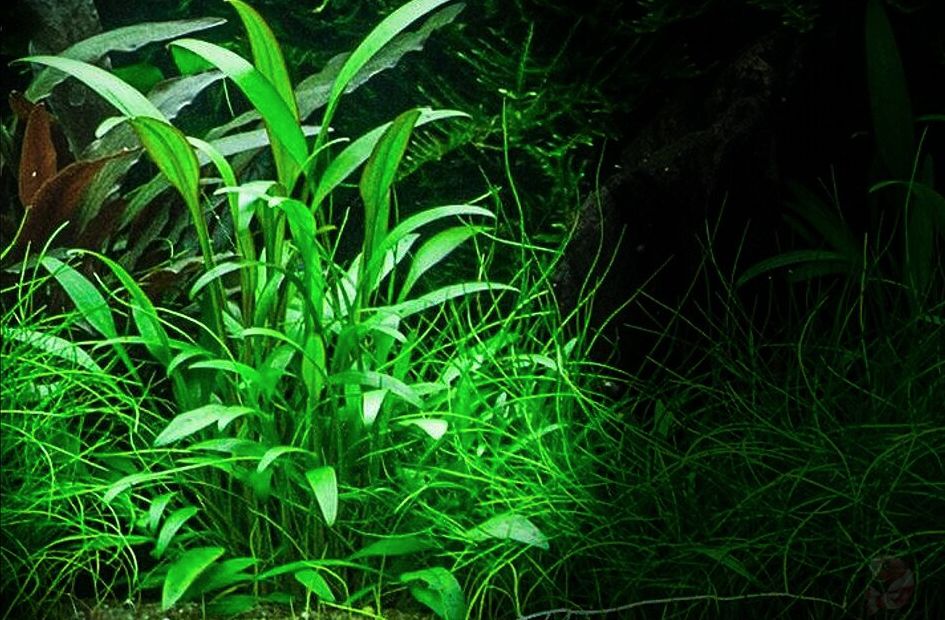
| Characteristic | Description |
|---|---|
| Scientific Name | Cryptocoryne x willisii |
| Common Name | Willis’ Cryptocoryne |
| Family | Araceae |
| Leaf Shape | Lanceolate |
| Leaf Color | Green, sometimes with reddish hues |
| Size | Can reach a height of 10-20 cm (4-8 inches) |
| Lighting | Moderate to low light conditions |
| CO2 Requirement | Can thrive without supplemental CO2, but benefits from it |
| Substrate | Nutrient-rich substrate preferred |
| Growth Rate | Moderate |
| Propagation | Runner formation, division of daughter plants |
| Care Level | Beginner-friendly |
Plant Habitat in the wild
Cryptocoryne, commonly known as crypts, is a fascinating genus of aquatic plants from the family Araceae. Valued by aquarists for their stunning foliage and adaptability, these plants can thrive in a range of aquarium conditions.
The name “water trumpet” comes from the unique appearance of their inflorescences, which resemble musical wind instruments. The genus name is derived from the Latin word “crypto,” meaning “hidden,” and the Greek word “koryne,” meaning “club,” referencing their distinctive flower structure. Each plant features a spadix—its reproductive organ—enclosed in a spathe, which contains cells that produce pollen and attract insects for pollination.
Cryptocorynes are primarily found in Southeast Asia, with a distribution range stretching from West India to East Papua New Guinea and from South China and North Vietnam to South Indonesia. These plants flourish in large islands with freshwater bodies, including Kalimantan (Borneo), Sri Lanka, Sumatra, and the Philippine Islands.
Unlike regions with persistent floods, these islands typically experience only brief flooding, as major rivers like the Irrawaddy and Mekong have steep banks that prevent prolonged water accumulation. In low-light conditions, cryptocorynes may exhibit slower growth rates.
Recent research over the past decade has significantly expanded our understanding of the natural habitats of various Cryptocoryne species. Many of these plants have adapted to diverse ecological niches, showcasing remarkable diversity. You can find them in streambeds, along riverbanks, and in small to medium rivers, usually no wider than 20 meters. Most species are amphibious, capable of growing both submerged and above water.
Despite their wide-ranging habitats, many Cryptocoryne species have specific ecological requirements and limited distribution zones. They thrive not only in rivers and streams with varying flow rates but also along shores and in temporary water bodies, such as abandoned river loops and puddles left after flooding.
Studies conducted in the late 20th century revealed that numerous Cryptocoryne species have broad natural habitats, with populations of the same species found across distant regions.
In summary, understanding the diverse forms and habitats of Cryptocoryne can enhance your aquarium experience. By providing optimal conditions and avoiding common pitfalls—such as neglecting water parameters or lighting—you can successfully cultivate these beautiful plants in your aquarium.
Difficulties in keeping
Cryptocoryne species vary significantly in their cultivation requirements, ranging from beginner-friendly varieties to those that pose a challenge even for seasoned aquarists. For instance, Cryptocoryne wendtii and Cryptocoryne beckettii are popular choices for beginners due to their resilience and low maintenance needs, while species like Cryptocoryne parva may require more precise conditions to thrive.
Most renowned crypt species are undemanding when it comes to tank conditions, making them suitable for aquariums without CO2 supplementation and low lighting levels. These plants prefer to absorb nutrients from the substrate, thriving in nutrient-rich, silty substrates without the need for additional liquid fertilizers.
While crypts naturally favor light, silty substrates, they are often adaptable enough to grow in coarser materials like sand or small gravel. This versatility allows them to flourish in a variety of environments, provided their substrate is rich in nutrients.
However, it is crucial to avoid common pitfalls, such as sudden changes in water parameters or neglecting substrate quality, which can hinder growth. By selecting the right species and maintaining optimal conditions, both novice and experienced aquarists can successfully cultivate these beautiful aquatic plants.
Care and keeping in a tank
For successful cultivation of cryptocorynes any fan of tank plants should put them into a tank timely. It is recommended to plant crypts into a tank with settled biological balance.
A tank about 100-120 cm long and 35-40 cm high will be the best for cultivation. This is due to the fact that most of crypts have more ornamental look when planted as a large group, which is hard to do in a short and narrow tank.
Water parameters
Cryptocorynes thrive best in slightly acidic to neutral water conditions, making water quality a key factor in their successful cultivation. Most species flourish within a pH range of 6.0 to 7.5; however, certain varieties can tolerate slightly more alkaline conditions. For instance, Cryptocoryne wendtii has shown adaptability to a wider pH range, while others, like Cryptocoryne beckettii, prefer the lower end of the spectrum.
These plants are remarkably adaptable to various water hardness levels, making them suitable for both soft and moderately hard water. Generally, a general hardness (GH) range of 2 to 15 dGH (35 to 265 ppm) is ideal for most Cryptocoryne species.
To maintain optimal water conditions, regular testing is recommended. If adjustments are needed, consider using products specifically designed to stabilize pH and hardness levels. By ensuring suitable water parameters, aquarists can help their Cryptocoryne plants thrive and display their full beauty.
Temperature
For most cryptocorynes, maintaining stable environmental parameters is crucial for their health and growth. One of the most important factors is temperature. Most Cryptocoryne species thrive within a temperature range of 72°F to 82°F (22°C to 28°C), with optimal conditions typically found between 23°C and 26°C. Using a heater with a thermostatic switch can effectively manage these temperatures.
When water temperatures drop below 20°C (68°F), growth usually halts, and prolonged exposure to even lower temperatures can lead to plant death. Additionally, it’s vital to maintain consistent temperature conditions, minimizing differences between day and night temperatures. While cryptocorynes can tolerate slight fluctuations—typically around 1-3°C—significant variations should be avoided to ensure their overall well-being.
Lighting
Lighting is a crucial factor for the effective cultivation of cryptocorynes. While many believe these plants are undemanding regarding illumination, the truth is that proper lighting is essential for their growth, as well as for the overall health of your aquarium.
To achieve the best light spectrum, consider using a combination of white and warm white fluorescent lamps or LED fixtures. A color temperature around 6500K (Kelvin) is ideal, as it promotes balanced plant growth and enhances the vibrant colors of the leaves.
If your aquarium houses other light-demanding plants, place your Cryptocoryne in slightly shaded areas, such as alongside the tank’s edges or beneath taller plants. This allows them to receive indirect light without being overwhelmed by excessive direct exposure.
Aim for a photoperiod of about 8 to 10 hours per day. Maintaining a consistent lighting schedule mimics natural day-night cycles, which is beneficial for plant health.
Substrate
For successful cultivation of cryptocorynes, providing the right substrate is essential. In their natural habitat, these plants thrive in a variety of soils, from muddy deposits to pebbles of different sizes. Often, the riverbeds they inhabit are covered with a thick layer of leaf litter in various stages of decomposition.
Most cryptocoryne species have strong, long, and highly branched root systems. Therefore, it’s recommended that the substrate layer in your tank be at least 6-8 cm thick. This depth helps prevent the formation of anaerobic zones, which can be detrimental to plant health.
To promote optimal growth, consider adding root fertilizers—such as tablets containing essential microelements and iron chelate—into the substrate. This will ensure that your cryptocorynes receive the necessary nutrients.
Avoid siphoning the substrate unless you notice a significant slowdown in plant growth, as many cryptocoryne species prefer a silty environment. Unlike other rosette plants, cryptocorynes are quite tolerant of root collar burial; they can thrive even if planted too deeply. If necessary, resist the urge to tear or cut the roots, as new roots will take several weeks to regenerate. When planting, you can gently arrange long roots in a spiral within the substrate to encourage healthy growth.
Fertilization
Cryptocoryne plants are generally heavy root feeders, meaning that a nutrient-rich substrate is essential for their growth. While the substrate will supply some necessary nutrients, supplementing with a liquid fertilizer designed for aquarium plants can significantly enhance their health and vitality.
When selecting a liquid fertilizer, look for products that provide essential macronutrients—such as nitrogen, phosphorus, and potassium—as well as important micronutrients like iron and manganese. These nutrients play crucial roles in plant development and coloration. Always adhere to the dosage instructions provided by the manufacturer to avoid over-fertilization, which can harm your plants and lead to algae growth.
By combining a quality substrate with the right liquid fertilizer, you can create an optimal environment for your cryptocorynes, helping them thrive in your aquarium.
CO2
Cryptocoryne plants can thrive without CO2 supplementation; however, introducing CO2 into your aquarium can significantly enhance their growth and improve leaf coloration. With adequate CO2 levels, you may notice faster growth rates and more vibrant hues, making your aquascape even more appealing.
If you decide to incorporate CO2, it’s crucial to regulate and monitor the levels carefully. Excessive CO2 can be harmful to fish and other aquarium inhabitants. Aim for a stable concentration, generally around 20-30 mg/L, to ensure a safe environment for all tank occupants.
For beginners, starting with a simple CO2 system and gradually adjusting levels can help you achieve the best results without overwhelming your aquatic ecosystem. By managing CO2 wisely, you can support your cryptocorynes in reaching their full potential.